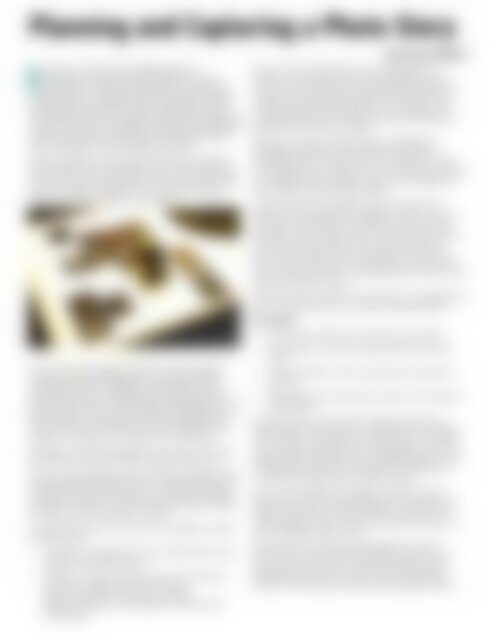NZPhotographer Issue 18, April 2019
As of December 2022, NZPhotographer magazine is only available when you purchase an annual or monthly subscription via the NZP website. Find out more: www.nzphotographer.nz
As of December 2022, NZPhotographer magazine is only available when you purchase an annual or monthly subscription via the NZP website. Find out more: www.nzphotographer.nz
Create successful ePaper yourself
Turn your PDF publications into a flip-book with our unique Google optimized e-Paper software.
Planning and Capturing a Photo Story<br />
In what is now known as the Golden Age of<br />
Photography – loosely the 1930s‐1950s, the picture<br />
story was king. The best photographers, such as Henri<br />
Cartier-Bresson, W. Eugene Smith, and Margaret Bourke-<br />
White were household names (try thinking of a current<br />
photographer who’s a household name!) and magazines<br />
such as Vu (France), Life (USA) and Picture Post (UK) were<br />
people’s main source for images of world events. That<br />
was until television came along and ruined it!<br />
These magazines all had specialised picture editors,<br />
whose craft was to edit (select, size, crop) the photos<br />
into picture stories. Examples of famous picture stories<br />
are W. E. Smith’s ‘Minamata’ and ‘Spanish Village’,<br />
and our own Brian Brake’s ‘Monsoon’.<br />
Once colour photography took over, picture editors<br />
would place the photographer’s developed slides<br />
(transparencies) on a light box and examine them in<br />
detail using a loupe magnifier before selecting which<br />
photos to print. As you can imagine, photographers and<br />
picture editors often argued over the published story.<br />
“How dare you crop that photo, the composition was<br />
perfect in camera!” Or “You left out my best shot!”<br />
Nowadays, we photographers can do our own postproduction<br />
work so no clash of egos need occur!<br />
If you’re a photographer who is always working towards<br />
capturing that one perfect shot, consider putting that<br />
approach aside and try using your camera to describe<br />
an event or location using a number of images. Initially,<br />
six photos is a good number to aim for.<br />
TV programmes and movies are put together using a<br />
variety of shots:<br />
• Long Shot, or Wide Shot: the overall location and<br />
people (establishing shot).<br />
• Full Shot: a person head to foot, and surrounds.<br />
Mid Shot: a person from the waist up.<br />
Close Up: head and maybe shoulders.<br />
Extreme Close Up: just the eyes, or some other<br />
small detail.<br />
By James Gilberd<br />
We can use the above list as a starting point to<br />
make our own photo story more interesting. Shoot<br />
in both portrait (upright) and landscape (horizontal)<br />
frames and include compositional techniques such<br />
as high viewpoint (looking down), low angle, wide<br />
and telephoto shots as well as including foreground<br />
elements to frame your subject.<br />
Before you cover an event (such as Wellington’s<br />
CubaDupa festival), write yourself a shot list by<br />
imagining some of the photos you might aim to get.<br />
Try to make this as varied as you can. Having a shot list<br />
is a professional tip to help cover-off the assignment<br />
with varied and interesting images.<br />
Once you have your photos, you can select the<br />
ones for final consideration digitally. Try this: use your<br />
software to edit down to your 20 or so photos and<br />
print them out, postcard size (10x15cm). This is cheap<br />
as chips. Then lay them out on a clear table and<br />
start moving them around, putting this one next to<br />
that, and you will see that some photos ‘talk to each<br />
other’ while others don’t. Gradually pare it down to six<br />
photos that tell your story.<br />
There should be variety in your final six; an establishing<br />
shot, a strong close up, and other things between.<br />
Remember:<br />
• No photo should do the same job as another.<br />
• Find graphic and formal relationships between<br />
shots.<br />
• It helps if there’s some visual harmony between<br />
them all.<br />
• Be prepared to exclude your best shot if it doesn’t<br />
fit the series!<br />
By planning to work in series, editing down from a<br />
wide selection of photos to a coherent set of images<br />
that conveys a strong sense of the event or location,<br />
you will quickly develop your photographic eye, your<br />
editing skills, and learn to pre-visualise images as well<br />
as being alert and in the moment to capture that<br />
‘must have’ image when it presents itself.<br />
Get your final selection together, tweak the files a<br />
bit and go make a decent sized print of each (A4 or<br />
larger). You’ll have a small portfolio of photos that<br />
work together to tell a story that reaches far beyond<br />
what a single image can tell.<br />
Remember that the best photographers are the<br />
ones who have learned to recognise what they’ve<br />
shot and to know how to select and present their<br />
photographs in their own way. This is an important<br />
aspect to achieving a personal photographic style.


















